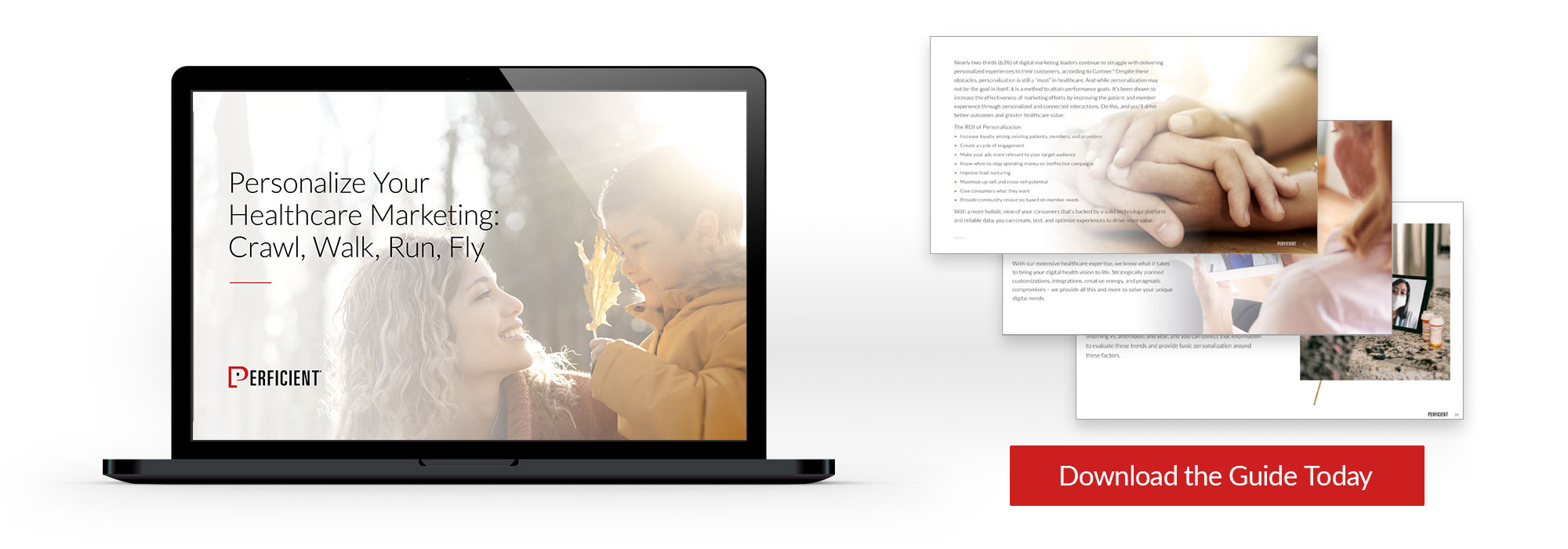Digital marketing has redefined segmentation in the age of mass media. With access to consumers’ online history, preferences, and behaviors, you can now better understand them and segment your marketing on an individual basis.
Creating personalized experiences for individual patients and members may seem overwhelming, but it doesn’t have to be. We guide our clients through the personalization spectrum, so they can start small and grow their personalization strategies over time.
The personalization spectrum is based on four personalization strategy types:
Contextual Personalization
Contextual personalization is the foundation upon which you can build more complex strategies. You can use specific environmental factors and circumstances about a consumer without having to know much about them as an individual. Contextual personalization includes:
- Geolocation
- IP lookup
- Device detection
- Temporal factors
Using tools such as geolocation and IP lookup, you can personalize based on an individual’s location or the organization with which they are affiliated. Geolocation allows you to provide information, such as an offer or event, tailored to your user’s specific location. With IP lookup, you can identify if a user is associated with an organization, such as a hospital or educational institution. With this data, the experience can be targeted to that specific audience.
Geolocation allows you to identify if your patient may live in a food desert, have difficulty getting to their doctor appointment, or may benefit from finding a practitioner that speaks another language or understands their culture.
Device detection allows you to determine the device consumers are using and whether they visited your site from a desktop or mobile device. You can also see which browsers your consumers use most often and make note of any trends that will differentiate your audience based on browser preference.
Other means of applying contextual personalization include temporal factors such as time of day or time of year. Are members coming to your site more at the beginning and end of the year, as insurance policies are updated and they seek out information, or in the month of December, as patients look to schedule last-minute appointments and use whatever remains in FSA accounts? Is there a season or month driving more traffic to your site?
Your audience may take different actions based on time of day and year, and you can collect that information to evaluate these trends and provide basic personalization around these factors.
Persona-Based Personalization
The next spectrum level is persona-based personalization, which aligns users’ needs with the characteristics that fit your pre-defined, target personas. A persona is a fictional character created as a proxy for a target audience. Personas categorize similar patterns of behavior that result in commonly held goals. Digital marketers create personas by evaluating primary and secondary sources, including ethnographic insight into people’s behavior based on direct observation and behavioral data.
As you gather more information about your patients or members (interests, intent, historical interactions, appointment history, etc.) you can associate them with established personas. Building a repository of this data will allow you to send more targeted messages and offers.
As more of this data is collected and applied to personas, it allows you to automate a decision-making engine that delivers content through sophisticated algorithms.
Behavioral Personalization
There is a trend in companies moving towards segmenting consumers based on interactions with web content and digital marketing campaigns. With behavioral-based personalization, you can leverage clickstream data to micro-levels including click events, funnel segmentation, and other first-party cookie data.
As healthcare consumers navigate your site, you begin to acquire “traits,” which you can use to target and deliver specific information. Traits can be based on behaviors, or on basic demographics, location, and other factors unrelated to users’ actions.
For example, an individual who visits a healthcare provider site and clicks on an article about managing diabetes may indicate that they fit the persona of diabetes care, meaning they have diabetes or cares for someone with diabetes.
Based on this information, your marketing automation platform can then send targeted emails with diabetes education, tips, and information to connect and engage with them. It’s important to note where this information came from: click-through to campaign content in a public space. The interaction didn’t occur within a secured form and it doesn’t fall under Protected Health Information (PHI) which is, of course, regulated by HIPAA.
By measuring actions taken on your site – pages viewed, searches performed, or documents downloaded – you can better understand individuals, make data-driven decisions, and take analytically derived actions for a specific channel or across all channels. Many health organizations are looking to take it a step further with activation data from digital health tools for an even richer source of insight about patients and members.
Journey-Based Personalization
Understanding where a consumer is on their healthcare journey is another way to target information. However, journey-based personalization is the most complex because you need to be able to quickly gather and act upon data from multiple sources, some of which may come from within your organization while other information sources are external.
For example, you know the individual previously described is interested in managing diabetes, based on their activity on your site. But you might not know that they also have high blood pressure and do not have a stable source of healthy food to eat. It is important to collect that information either through voluntary input or the integration of PHI-free secondary sources. Using this rich data from multiple sources, you can better target the experience by providing tailored content around both diabetes and high blood pressure.
The bottom line when it comes to applying personalization strategies is to start simple.
Introducing complexity too early can slow implementation and analytics processes.
You need to evolve personalization strategies by establishing baseline metrics and creating business rules first, then adding complexity over time.
Learn more about personalization in healthcare
Healthcare consumers have high expectations for a personalized (or at least a relevant) experience, but many healthcare organizations struggle with delivering it. This is especially difficult with the need to avoid invasiveness and inherent data bias towards the social determinants of health that could perpetuate inequities. A powerful digital foundation gives you the ability to personalize experiences.
While your organization may not yet deliver deeply personalized experiences, the potential is there. Partnering with a digital consultancy that specializes in healthcare solutions will help you reach that potential. Our experienced and award-winning team will not only help you implement the solution but also create a strategy to align the people and processes to embrace it.
Gain step-by-step guidance on how to overcome challenges, expand use cases, comply with regulations, combat bias in AI and ML models, successfully implement/execute/grow strategies, and use CDP/CRM/DXP to deliver personalized experiences through our interactive guide.
GET THE GUIDE: Personalize Your Healthcare Marketing: Crawl, Walk, Run, Fly


